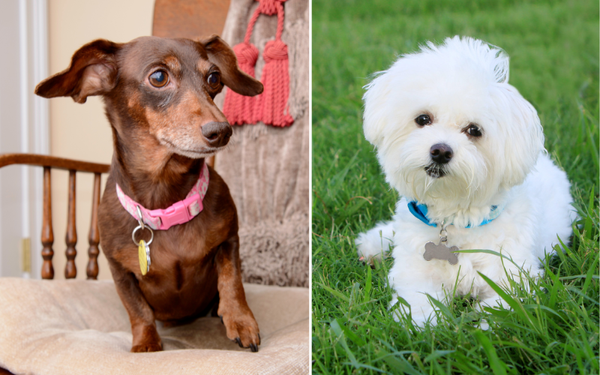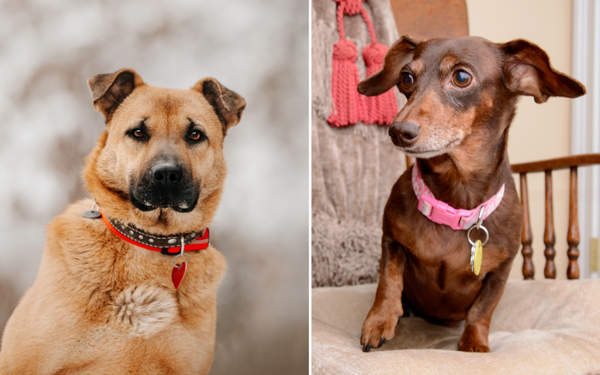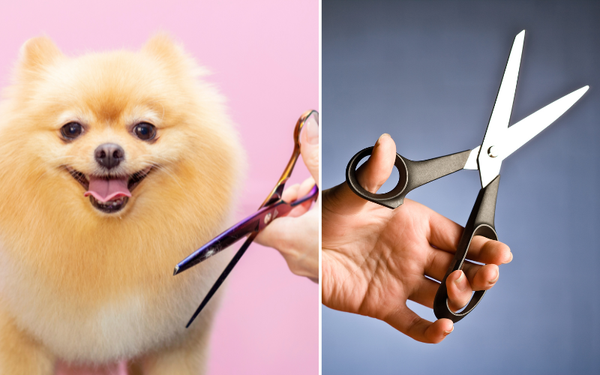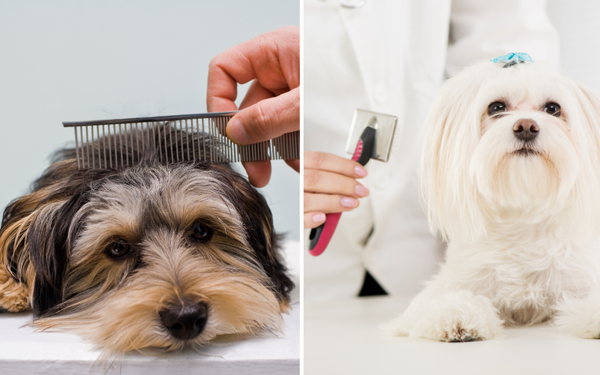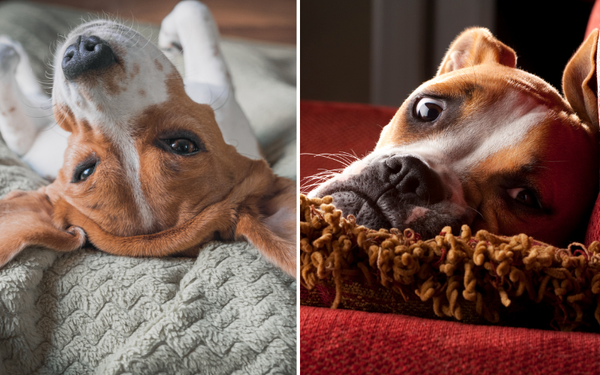Picture a freshly groomed dog: shiny coat, neatly trimmed hair, and a wagging tail that doesn’t stop. The secret behind this picture-perfect grooming? The right set of dog grooming scissors. But “how do I choose dog grooming scissors” from the numerous options available in the market? This guide will walk you through everything you need to know about selecting the best dog grooming scissors for a perfect groom.
Key Takeaways
- The right type of dog grooming scissors is crucial for precision, comfort, and safety; straight, blending, and curved scissors each serve specific grooming purposes, handling different tasks like shaping, trimming large areas, and thinning fur.
- The material and edge of the scissors’ blades, such as the robust beveled or the sharp convex, as well as the steel quality, influence their durability, cutting performance, and suitability for different coat types and grooming tasks.
- Ergonomics and the physical comfort of the groomer are vital; handle designs, weight, and the balance of the scissors affect control, precision, and the prevention of strain during grooming.
Understanding the Basics of Dog Grooming Scissors
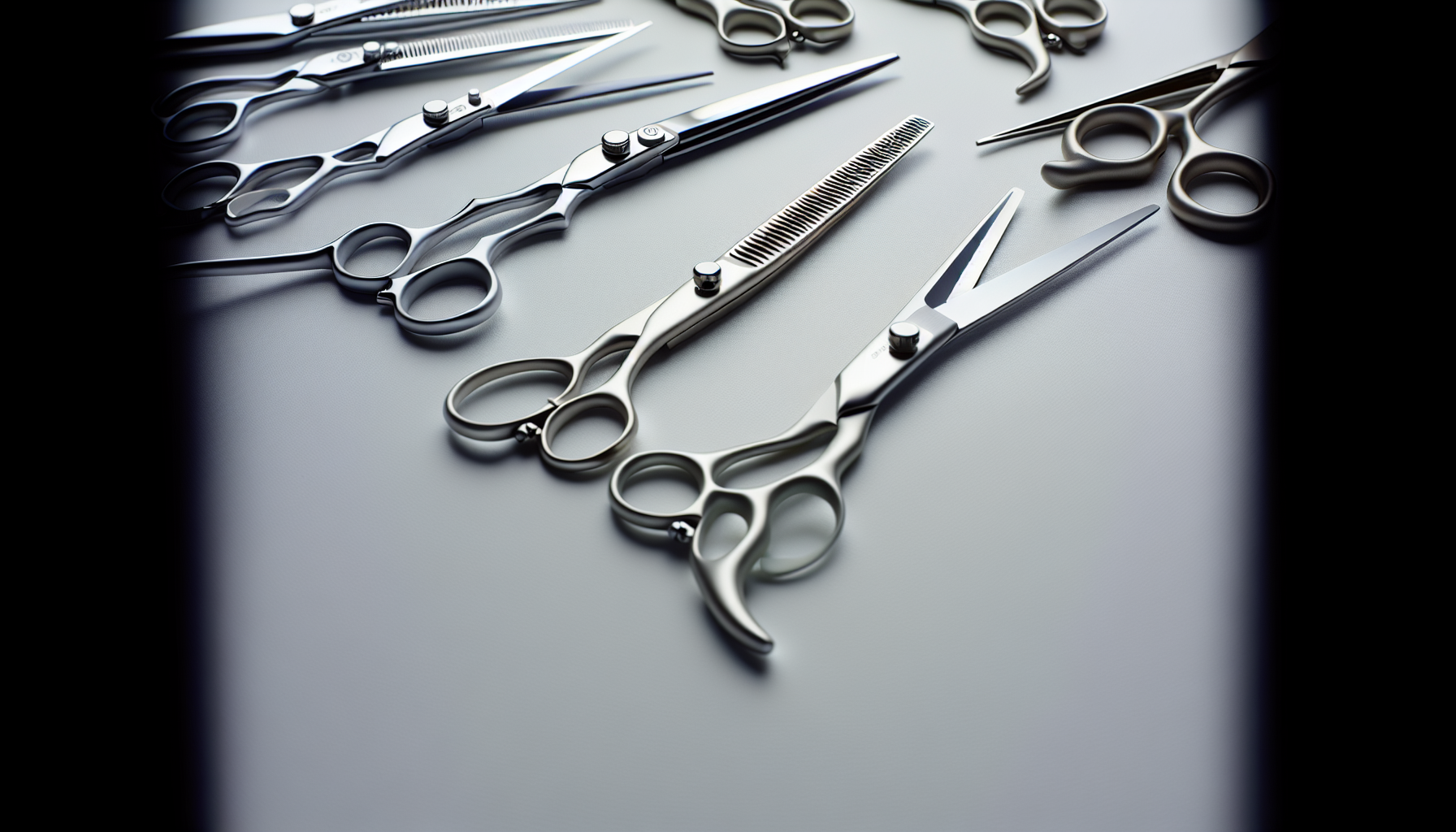
Professional groomers agree that selecting the appropriate scissors is the initial step towards a successful grooming session. The type of grooming scissors you choose can make a significant difference in the grooming process, affecting everything from the precision of the cuts to the comfort of the groomer. The three types of scissors commonly utilized in dog grooming are straight, blending, and curved scissors. Each has its unique role in achieving the perfect groom.
Dog scissors are the quintessential tool in a grooming kit. They are used for uniformly trimming large areas of fur, and they play a pivotal role in setting the desired length on the body and legs of the dog. Choosing the right grooming scissors is essential for achieving a professional finish.
Thinning shears, on the other hand, are used for a different purpose. They help to achieve a seamless and uniform appearance, reduce bulk in thick coats, and are excellent for blending hair.
Last but not least, the curved scissors, also known as curved shears, are the artist’s tool in the grooming world. They are primarily utilized for shaping curved areas on a dog’s body and are particularly effective for adding angles or shapes to frizzy coat textures.
The Role of Straight Scissors in Precision Cuts
Straight scissors are fundamental to any dog grooming session. They are designed to give a smooth and precise cut across large areas of the fur, allowing the groomer to quickly establish the desired length of the coat. However, the use of straight scissors involves more than just cutting. It demands meticulous handling for a safe and comfortable grooming experience.
The correct way to hold straight scissors involves:
- Inserting your ring finger and thumb into the eye holes, with only the top of your fingers in the holes.
- When using the scissors, it’s important to move your thumb evenly and slowly, avoiding opening the scissors too wide or applying too much force.
- The offset handle design of straight scissors is specifically designed to reduce hand fatigue and provide a more ergonomic and comfortable experience during grooming sessions, making them one of the best grooming shears.
The rounded tip of the scissors also enhances safety by preventing accidental poking of the pet during grooming.
Mastering the Art of Thinning with Thinning Shears

Thinning shears are often the preferred tool of many professional groomers. They are primarily used to:
- Create layers in a dog’s coat
- Achieve a seamless and uniform appearance
- Reduce bulk in thick coats
- Eliminate tangled fur
- Blend a trimmed face for a more natural look
One of the key techniques with thinning shears is to work in small, incremental cuts, ensuring only a small amount of hair is removed at a time. By working around the area and addressing any unevenness, you can create a smooth and even coat. Thinning scissors should be used after straight scissors to refine the area and correct any errors made with the straight scissors. They come with a varying number of teeth, with those having a higher number providing a smoother and more refined effect.
Curving to Perfection: When to Use Curved Scissors
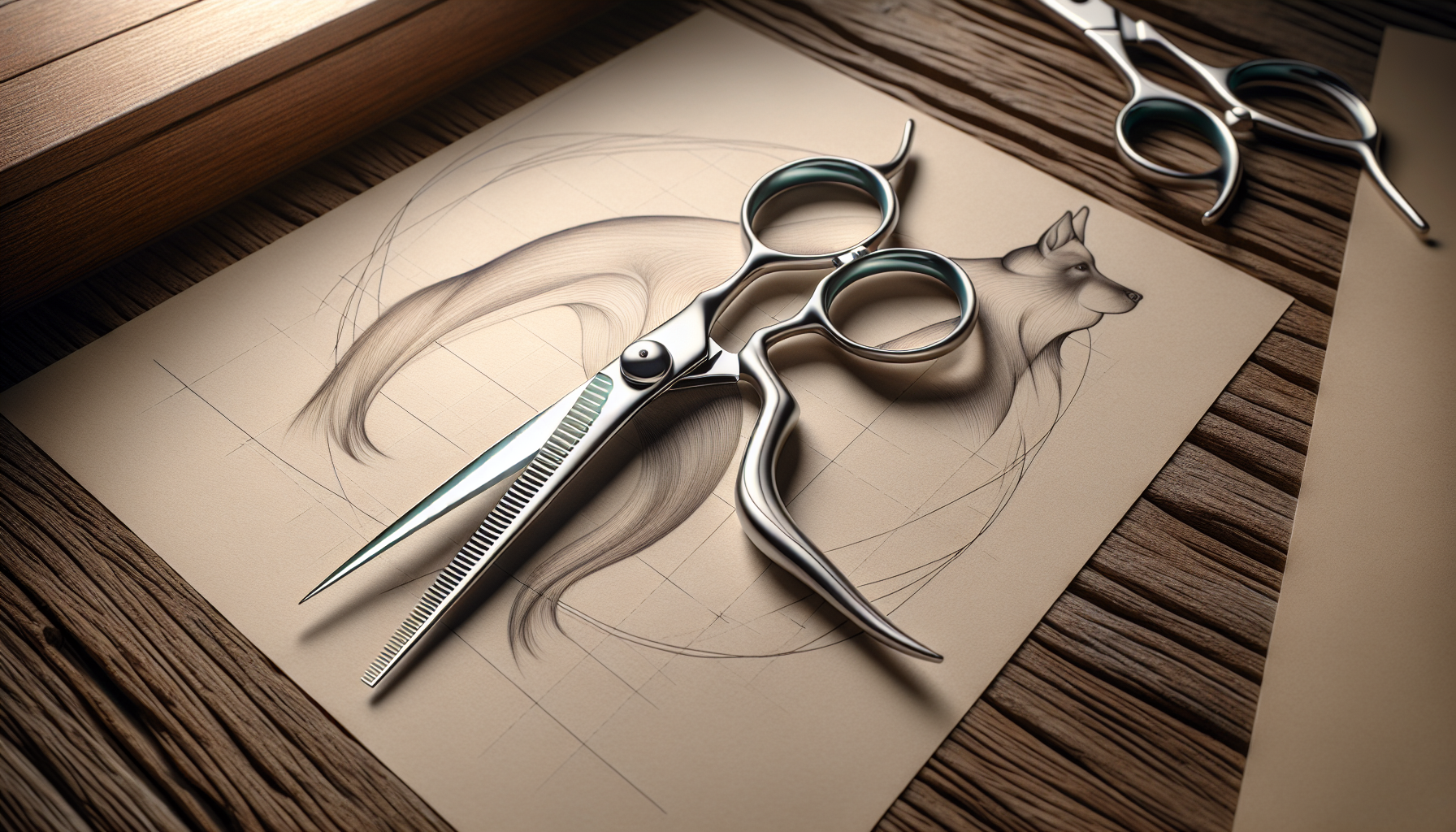
Curved scissors can bring a creative flair to your grooming sessions. They are primarily utilized for shaping curved areas on a dog’s body, such as around the face or tail. With curved scissors, you can create top knots, shape faces, trim ears and feet, and set angulation when flipped.
It is recommended to use a swift, continuous motion with curved scissors, completing one area of the body before moving on to another. To enhance your skill set with this tool, it is beneficial to have one or two pairs of curved scissors. Curved grooming scissors come in a range of lengths, from 4 inches to 10 inches, to accommodate various grooming tasks.
Selecting the Right Scissor Material for Durability and Sharpness
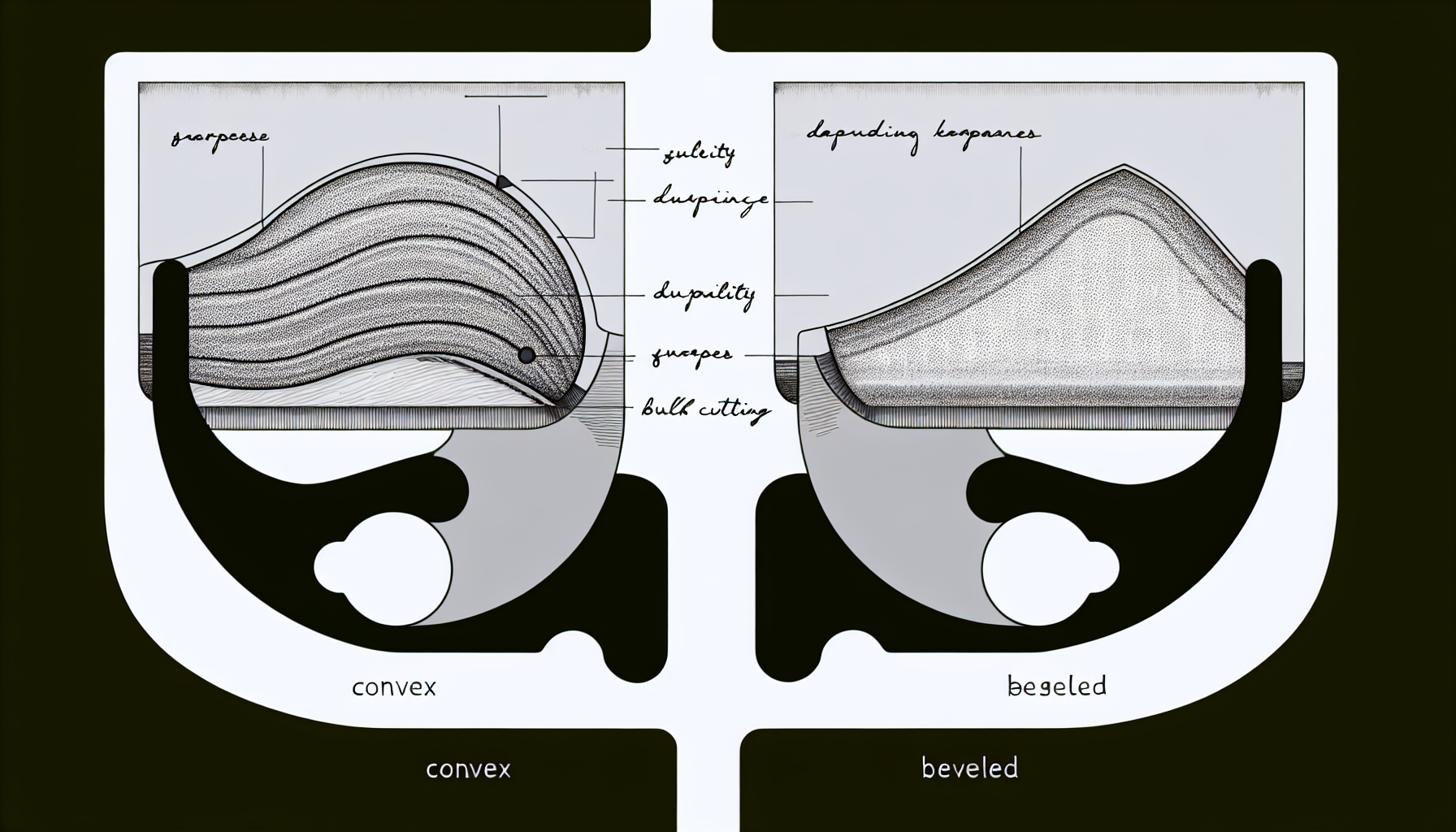
The material from which the scissors are made greatly affects their longevity and cutting edge. Two primary categories of blade edges for dog grooming scissors are beveled and convex. Beveled blades are known for their robustness and are effective for managing denser coats, while convex blades provide a sharp edge for precise cuts, making them suitable for delicate finishing tasks.
However, beveled blades, despite their durability, have a less sharp edge compared to convex blades, which may lead to challenges when trimming thick coats. They can also lose their sharpness more quickly if not handled or stored properly.
The quality of the steel used in making the scissors also plays a significant role in their sharpness and durability. For instance, Japanese steel is highly esteemed for crafting sharp convex edges, while German steel is known for its hardness and robust beveled edges.
Convex Blades vs. Beveled Blades: Knowing the Difference
When it comes to the blade edge of grooming scissors, the choice between the convex and beveled blades can make a significant difference in the grooming experience. Convex blades, known for their exceptionally sharp edge, are suitable for precise grooming tasks. On the other hand, beveled blades have a less acute edge but offer greater durability and may feature serrated edges for better hair grip during cutting.
Convex blades are an excellent choice for various dog coat types, particularly coarse dog’s coat, as they prevent hair strands from bending or snagging, resulting in precise cuts and a neat appearance. Conversely, beveled blades are most effective for blunt cutting, especially for thicker coats, due to their durability and serrated edges which help hold the hair in place and prevent it from being pushed forward during a cut.
Dog grooming shears, also known as professional dog grooming scissors, are best suited for finishing touches in dog grooming because of their exceptionally sharp edge, which allows for a seamless cutting action without requiring excessive force and aids in keeping fur strands in place for more accurate trimming. A professional dog groomer would appreciate the precision these shears provide.
Ergonomics and Comfort: Finding the Best Fit for You
For professional groomers, who rely heavily on their hands, comfort is a major factor in choosing grooming scissors. Utilizing uncomfortable equipment can lead to physical strain and fatigue. Furthermore, using scissors designed for your dominant hand can significantly enhance comfort and efficiency while grooming a dog’s coat.
The weight of the scissors also directly impacts comfort and control. Choosing the right weight can result in improved handling and precision.
Handle Designs That Suit Your Grip
The design of the scissors’ handle is key in ensuring an efficient and comfortable grooming experience. Some important features to look for in the handle design include:
- Ergonomic designs that help minimize the risk of repetitive motion injuries
- Light and ergonomic designs for ease of use
- Handles that cradle the fingers for a secure grip
These features, including a finger rest, contribute to reducing hand fatigue during grooming.
There are various handle designs available for dog grooming scissors, including:
- Crane grip
- Offset handle
- Straight handle
- Swivel handle
- Opposing handle
The offset handle design, for instance, offers a natural hand position, minimizing strain on the fingers and allowing for improved control during grooming. This is particularly important for prolonged grooming sessions and precise grooming work.
On the other hand, opposing handle designs can exert more strain on the:
- hand
- wrist
- arm
- shoulder
- neck
- back
This can result in heightened hand fatigue when compared to offset and crane-handle designs.
Balancing Weight and Size for Control
In terms of control and accuracy during dog grooming, the weight and size of the scissors are considerably important. Well-balanced scissors with equal weight distribution between the handle and the blades tend to offer better manageability and control. Generally, lighter shears are easier to handle and provide improved control.
Smaller grooming scissors offer improved control by enabling greater precision due to their shorter length. They are equipped with features such as offset handles that enhance control during cutting, especially in delicate areas, and are ideal for beginners and grooming smaller breeds.
On the other hand, ensuring a balance between weight and size in dog grooming scissors can enhance precise and comfortable grooming, enabling groomers to maintain optimal control and maneuverability, resulting in consistent grooming outcomes while reducing the likelihood of strain or fatigue during grooming sessions.
Precision Meets Style: Blade Length and Dog Size Considerations
You must consider the blade length of grooming scissors to ensure accuracy and efficiency in grooming. It is important to select the blade length that matches the size of the dog being groomed. For instance, small dogs may require smaller blades for delicate areas, while larger dogs with thicker coats may benefit from longer blades.
Small Dogs, Delicate Work: Shorter Blade Advantages
When grooming small dogs or working on delicate areas, shorter blades offer several advantages. They provide increased precision and control, allowing groomers to navigate sensitive areas like the face, paws, and ears with ease.
Shorter blades enhance control and precision by offering groomers increased maneuverability and accuracy, particularly when working on delicate areas or intricate styles for small dogs. Professional groomers suggest using straight scissors that are 6 or 7 inches in size for small dog breeds, as these sizes provide excellent control for precision grooming work.
Larger Breeds, Longer Blades: Efficiency in Every Snip
On the other hand, when it comes to grooming larger breeds or dogs with thick coats, longer blades are more efficient. They allow groomers to remove more coat with each cut, improving productivity and achieving a more polished result.
Longer blades can effectively handle tough knots and tangles without causing discomfort to the dog. They are particularly useful for:
- blending short areas with longer lengths
- coarser coat breeds like terriers
- very thick coats
- removing bulk
The even teeth on the blade result in a smoother cut, making longer blades ideal for achieving a smooth clip and are suitable for all-over grooming or as a finishing touch.
Maintenance Matters: Keeping Your Grooming Scissors in Top Shape
Keeping your grooming scissors in optimal condition is key to achieving impeccable grooming results. Regular maintenance and cleaning not only contribute to their longevity but also ensure client satisfaction following their grooming sessions.
Proper cleaning and maintenance procedures for shears involve the following steps:
- Remove trapped hair and fur.
- Ensure thorough drying of the shears.
- Apply shear lube.
- Execute an open and close motion to evenly distribute the lubricant.
- Appropriately store the scissors in a secure location to prevent damage.
Regular Cleaning and Sterilization Routines
Regular cleaning and sterilizing your grooming scissors help preserve their optimal function, cutting performance, and prolong their lifespan. They also play a crucial role in preventing the spread of diseases.
The proper procedure for cleaning dog grooming scissors involves wiping them down to remove debris, applying a cleaning solution made for scissors, opening the blades to a 90-degree angle, using a dry soft cloth to remove moisture, and using a small, soft-bristled brush to dislodge any trapped hair or debris between the blades. Recommended products for sterilizing dog grooming scissors include Abbfabb’s Dog Grooming Scissor Oil, alcohol, Barbicide, or Clipit Ice Care Spray.
Sharpening and Tension Adjustments
Sharpening your grooming scissors is just as crucial as cleaning them. A sharp scissor ensures smooth, precise cuts and extends the lifespan of the tool. It is recommended to sharpen dog grooming scissors every 3-6 months, although the specific interval may depend on the level of care and maintenance they are provided.
Maintaining appropriate tension is crucial for the performance of dog grooming scissors as it facilitates smooth blade gliding, clean cutting, and minimizes unnecessary wear. Additionally, it helps in preventing discomfort or injury to the groomer’s hand and wrist, ultimately ensuring a precise and comfortable grooming experience.
The tension of dog grooming scissors can be adjusted by:
- Holding them horizontally and opening them.
- If the blades close immediately with no resistance, the tension should be tightened.
- If they do not close easily, the tension should be loosened.
Professional Insights: Advice from Experienced Groomers
When selecting grooming scissors, learning from the experience and advice of seasoned groomers can be beneficial. They can provide valuable tips on selecting the most suitable scissors for various dog breeds and grooming tasks. Professional groomers carefully consider factors such as the design and ergonomics of the scissors, as well as the specific grooming needs of different dog breeds, when selecting scissors.
For inexperienced groomers, a scissor starter kit can be a great place to start. A starter kit typically includes:
- A 4.5” bull nosed scissor for trimming delicate areas
- A 7” straight scissor for bodywork on small to medium dogs
- A single edge 36 teeth thinning scissor for shaping and sculpturing
Top scissor brands that professional groomers often suggest include Andis, Master Grooming Tools, Dubl Duck, Heritage, Loyalty Pet Products, and Geib.
The Selection Process: Matching Scissors to Grooming Needs
Selecting the appropriate scissors for your grooming needs is a vital step towards achieving the ideal groom. The selection process should take into account the scissoring style and the type of work involved, ensuring that the chosen scissors are suitable for the specific grooming tasks that need to be performed.
Different types of grooming scissors are suitable for achieving different styles. For instance, when grooming poodles, straight-edged, curved, and thinning scissors are most suitable as they align with the precision necessary for styling this particular breed’s coat.
Accessorize Your Grooming Kit
Equipping your grooming kit with a variety of tools, alongside scissors, can streamline the grooming process for multiple breeds. A thorough dog grooming kit includes tools such as:
- straight shear
- curved shear
- thinning shear
- pin brush
- soft slicker brush
- rubber curry/shampoo brush
- combination comb
- dog rake
The presence of a diverse range of dog grooming supplies, including various grooming tools, can simplify the grooming process for various breeds. Several reputable brands for dog grooming accessories are:
- Flying Pig
- Waterpik
- Chris Christensen
- Kenchii
- Andis
- Wahl
- ConairPROPET
- Pawshelf
- Master Grooming
- FURminator
Summary
In conclusion, choosing the right grooming scissors can make a significant difference in the grooming process, affecting everything from the precision of the cuts to the comfort of the groomer. From understanding the basics of dog grooming scissors, selecting the right scissor material, balancing weight and size for control, to keeping your grooming scissors in top shape, every step plays a crucial role in achieving the perfect groom. So, take a mindful approach to select your grooming tools, and happy grooming!
Frequently Asked Questions
What should I look for in dog grooming scissors?
Look for straight cut scissors, with 8-inch scissors being best for curly coats like Poodles or Bichons, and 6 or 7-inch scissors being ideal for small breeds like Shih Tzus. The smaller the shear, the more precise the cutting. A 4-inch pair is ideal for trimming hair around feet, legs, or eyes.
Are curved or straight scissors better for dogs?
Curved scissors are better for grooming dogs because they allow groomers to follow the natural contours of the dog's body for a more polished and professional finish.
How often should I sharpen my dog grooming scissors?
You should sharpen your dog grooming scissors every 4-6 months, with a minimum of once a year, based on usage and scissor quality.
What types of grooming scissors are most suitable for achieving poodle cuts?
For achieving poodle cuts, straight-edged, curved, and thinning scissors are the most suitable types of grooming scissors. Choose these for the best results.
What is the importance of maintaining appropriate tension for the performance of dog grooming scissors?
Maintaining appropriate tension is crucial for the performance of dog grooming scissors as it facilitates smooth blade gliding, clean cutting, and minimizes unnecessary wear, ensuring effective grooming without damaging the scissors.
You Might Also Like...






